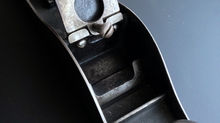The Mystery of Stanley Canada

I search for old planes where ever I happen to be and recently on a trip to the far north, (Canada and Alaska) I found a couple in some remote areas in British Columbia. One was a US made plane, the other was made in Canada. It's not the first one I've encountered or studied made there but there is a definite difference when you compare the two and the more I did, the more confused I got.
Stanley began producing tools at Roxton Pond, Quebec in about 1908 or so after acquiring (in 1907) land and significant water rights from W.S. Bullock president of the Roxton Tool and Mill Company, important properties which included "The absolute control of the water power, two dams, including the new one four hundred and twenty-one feet long, twenty feet high, giving thirty-four feet of head on water wheels, the electric plant with a capacity of five hundred lights extending over the entire village and plants; grist, sowing, planning mills; foundry, machine shops and complete manufacture of carpenter planes and "S" wrenches, with all equipment herein..." (ref: http://swingleydev.com/ot/get/6959/thread/) Stanley, at the time was under the visionary leadership of President William S. Hart, whom which the SW and heart trademark were established in homage in 1919, and who oversaw the first major expansion and sustained growth of the company.




I am not aware of any published type studies on Stanley Canada planes but I believe that this one was manufactured in about 1945 based on some characteristics I've observed in others. The SW cutter on this example is stamped "245" which I have learned is the production date, second quarter of 1945, more than 20 years after the same mark was discontinued in the US. Like US planes made during WWII many were cast without frog adjusting screws, as this one, but typically they will usually have steel tote and knob hardware and the depth adjusting knob would either be steel or Bakelite. This one has brass, not an uncommon occurrence as rationed commodities became more plentiful towards the end of the war. The lever cap is cast with a kidney shaped hole and the typical patent number Stanley used on US planes manufactured after 1935 and continued to use after 1942. This one does have a nickel plated finish while most US wartime caps were plain and roughly finished generally until after about 1945. In addition, the frog has a ogee shape which is also a post Sweetheart era characteristic on US planes. My experience with other Canadian made Stanley planes indicates that they used characteristically similar components much later than they were used in the US, hence the SW "Y" trademark with a manufacture date in 1945. Admittedly, this is all conjecture based on published Bailey type studies and again, the one thing that is most consistent about war-time planes is their total lack of consistency, which in this case is compounded further in that Stanley Canada apparently did things a bit differently than their US cousins. Then again, this may just be a pre WWII plane made to different Stanley Canada specs with a replacement cutter...but is sure does look original in any case. All very interesting to say the least.
Needless to say, there are enough of these Canadian Stanley planes about the US and Canada to merit further study. Perhaps one of my colleagues to the north will embrace the opportunity during one of those cold Canadian Winters, that is when you aren't watching Hockey.































